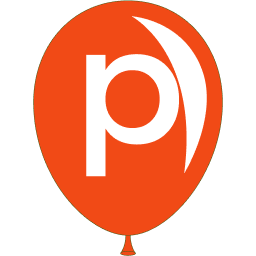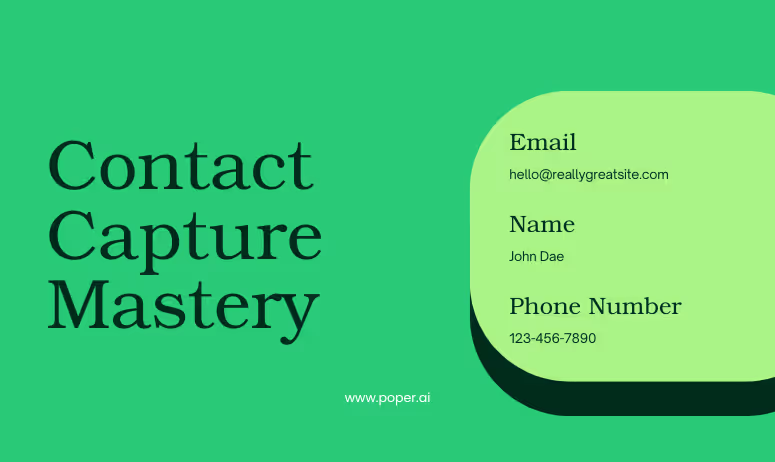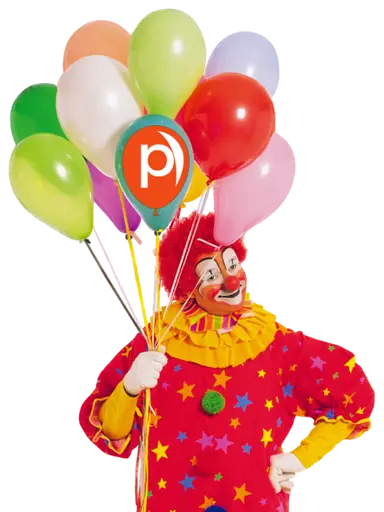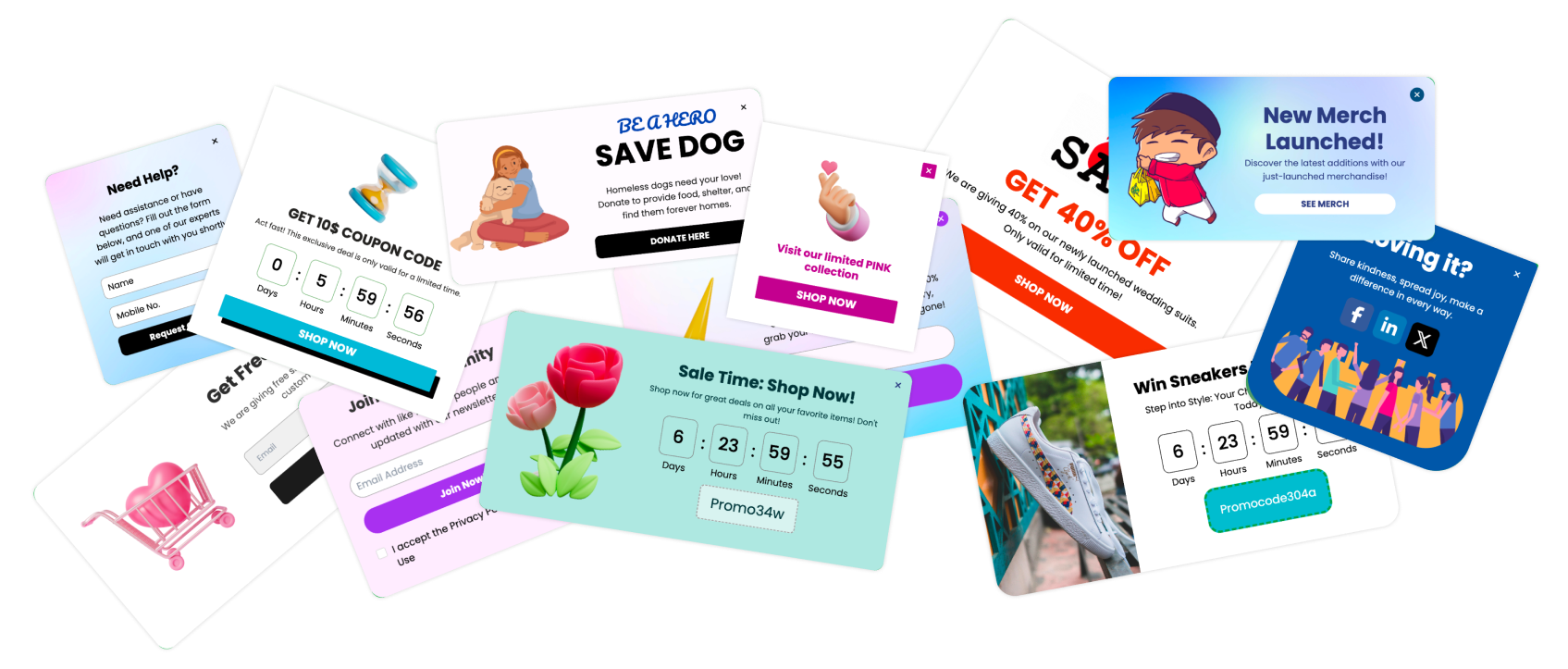Introduction to Contact Capture
"Every visitor is a potential relationship — contact capture is how you start the conversation."
Contact capture is the process of collecting visitor information — such as names, emails, or phone numbers — through forms, popups, or interactive website elements. This allows businesses to start meaningful engagement with potential customers.
What Is Contact Capture?
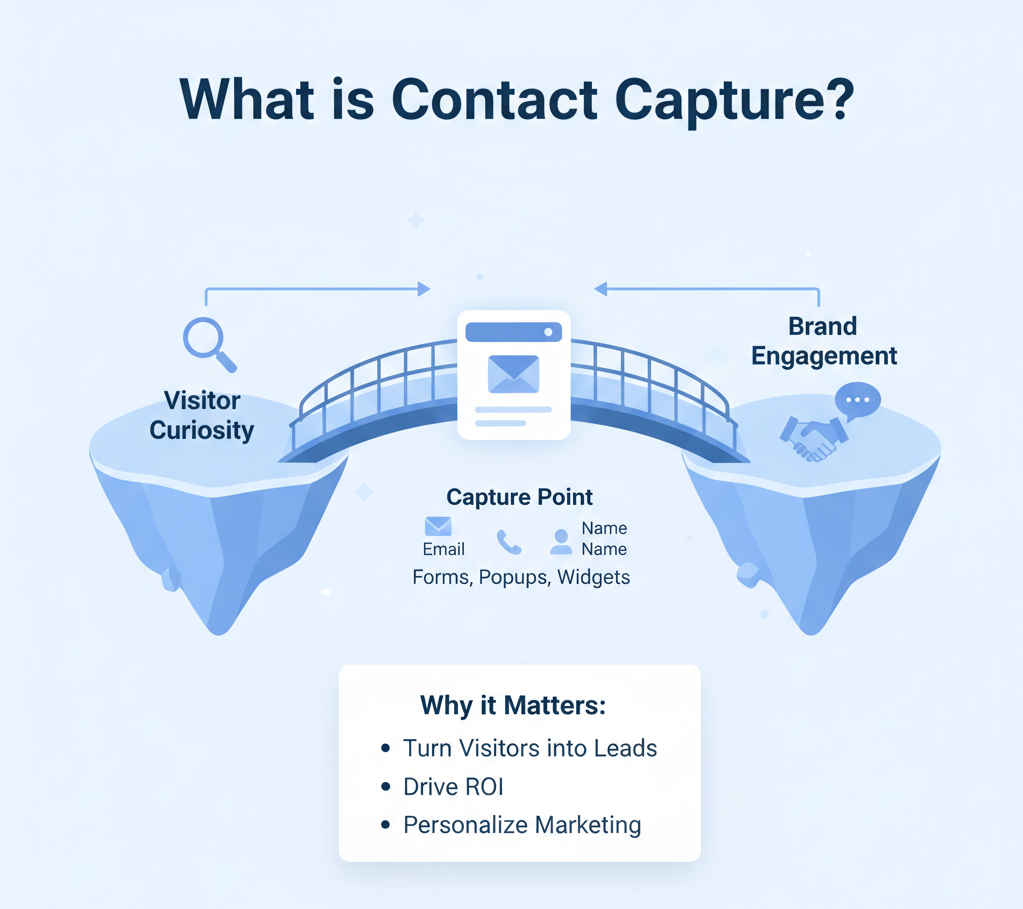
Contact capture is more than a signup form. It’s a bridge between a visitor’s curiosity and a brand’s opportunity to engage. The goal is to obtain permission to communicate and provide value in return.
Common elements of contact capture:
| Element | Example | Purpose |
|---|---|---|
| Form Fields | Name, Email, Phone Number | Identify and connect with the visitor |
| Offer | Free eBook, Discount, Trial Access | Motivate submission |
| Trigger | Popup, Inline Form, Gamified Widget | Display at the right moment |
| Follow-Up | Welcome Email, Thank You Message | Begin engagement |
Why It’s Crucial for Every Business
Traffic alone isn’t enough. Without capturing contacts, visitors leave without giving you a chance to convert them.
Why contact capture matters:
Turns visitors into leads: Every captured email is a chance to re-engage.
Drives measurable ROI: Track conversions and revenue directly.
Enables personalized marketing: Tailor content, offers, and messages.
Builds credibility and trust: Professional, transparent capture increases confidence.
The Evolution from Basic Forms to Intelligent Popups
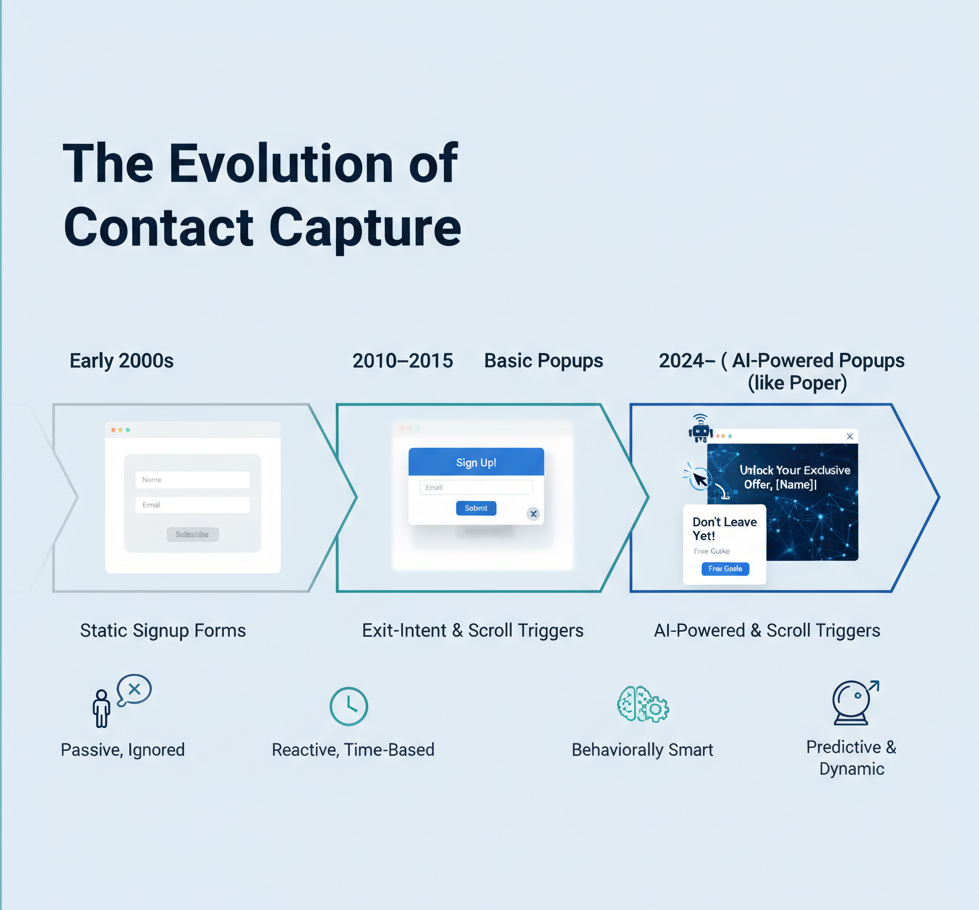
Contact capture has evolved from simple forms to dynamic, behavioral, and AI-driven methods:
| Era | Method | Experience |
|---|---|---|
| Early 2000s | Static Signup Forms | Passive, often ignored |
| 2010–2015 | Basic Popups | Reactive, time-based |
| 2016–2020 | Exit-Intent & Scroll Triggers | Behaviorally smart |
| 2024– | AI-Powered Popups (like Poper) | Predictive and dynamic |
The Link Between Contact Capture and Conversion Growth
Effective contact capture is directly tied to higher conversions:
Visitors who submit info show intent and interest.
Personalized follow-ups increase conversion rates up to 3x.
Data-driven capture improves lead quality and reduces churn.
The Psychology Behind Effective Contact Capture
Understanding why visitors share their information is key to designing capture experiences that convert. It’s not just about forms or popups — it’s about human behavior, trust, and timing.
Why Visitors Share Their Contact Information
Visitors give their information only when they see benefit in return. The psychology is simple:
Reciprocity: People are more likely to share details if they receive something valuable first (free guide, discount, or exclusive content).
Curiosity: A hint of reward or mystery can entice a visitor to engage.
Trust: A clear, professional website signals credibility and encourages sharing.
Example Table: What Motivates Contact Sharing
| Motivation | Example Offer | Effect on Conversion |
|---|---|---|
| Reciprocity | Free eBook or checklist | High likelihood of submission |
| Reward | Discount coupon | Immediate incentive to act |
| Curiosity | Gamified quiz results | Interactive engagement |
| Trust | Verified badge, privacy policy | Comfort in sharing data |
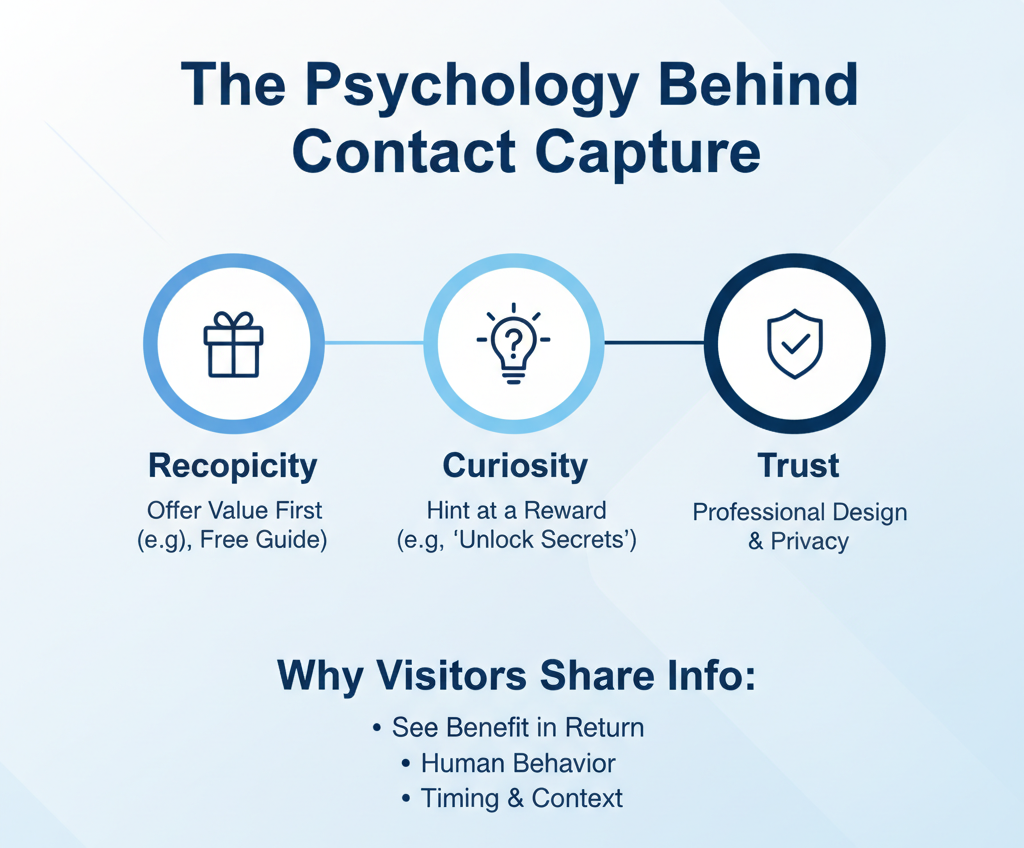
Building Trust Through Transparency and Value
Trust is non-negotiable. If a user doubts how their data will be used, they won’t share it.
Ways to build trust:
Show a privacy notice: Clearly state how the information will be used.
Offer real value upfront: Free resources, trials, or tools make sharing worthwhile.
Use professional design: A clean, polished form or popup boosts credibility.
Example: A popup offering a free 7-day SaaS trial is far more effective than a generic “Subscribe Now” box, because the value is clear.
The Role of Timing and User Intent
Even the best offer fails if it’s shown at the wrong moment. Timing is everything:
Immediate popups may annoy first-time visitors.
Scroll triggers (after 50% of content) show value before asking for info.
Exit-intent popups capture visitors about to leave, offering a final chance to engage.
How Emotions, Colors, and Copy Influence Decision-Making
Human psychology drives almost all interactions. Small elements can make a huge difference:
Colors: Bright buttons (orange, green) trigger action; blue conveys trust.
Copy: Simple, benefit-driven messaging works best (“Get Your Free Guide Now”)
Emotion: Tap into curiosity, urgency, or excitement to boost submissions.
Example: A popup saying:
“Unlock exclusive tips to triple your website traffic – enter your email now!”This uses curiosity + clear value + CTA to trigger action.
Key Elements of a High-Converting Contact Capture Strategy
Having a strategy for contact capture is more than just putting a popup on your site. The best-performing campaigns combine value, design, timing, and incentives to maximize conversions.
Strong and Clear Value Proposition
Visitors won’t give you their details unless they see immediate value. Your offer should answer the question: “What’s in it for me?”
Examples of strong value propositions:
Free eBook: “Get the ultimate guide to boosting website conversions”
Discount: “Save 20% on your first purchase”
Access: “Unlock exclusive webinar content”
Minimal Friction in Forms (Ask Only What’s Needed)
Less is more. Every extra field reduces the likelihood of submission.
Best practice:
Ask for name and email only for initial capture.
Add extra fields (phone, company) later in the funnel.
Use auto-fill and validation to make the process effortless.
Example Table: Fields vs Conversion Impact
| Number of Fields | Conversion Rate |
|---|---|
| 1–2 fields | 60–70% |
| 3–4 fields | 40–50% |
| 5+ fields | 20–30% |
Eye-Catching Design and Powerful CTAs
Design and CTA copy play a huge role in conversions:
Buttons: Bright, contrasting colors draw attention.
Text: Use action-oriented language like “Download Now” or “Claim Your Discount.”
Visuals: Include supporting images or icons to make your offer tangible.
Example: A gamified popup showing a spinning wheel for a discount instantly grabs attention and increases submission rates.
Behavioral Triggers and Contextual Targeting
Smart triggers improve results significantly:
Scroll-based triggers: Show a popup after the visitor reads 50–70% of content.
Time-based triggers: Display after 30–60 seconds on-page.
Exit-intent triggers: Capture users about to leave.
Behavioral triggers: Show different popups based on page visited, previous interactions, or geolocation.
Incentives That Encourage Submissions (Freebies, Trials, Offers)
Everyone loves a reward. A strong incentive motivates action:
Freebies: Ebooks, guides, templates
Discounts: Percentage off, free shipping
Gamification: Quizzes, Spin-to-Win, Contests
Exclusive content: Webinars, VIP newsletters
Types of Contact Capture Methods
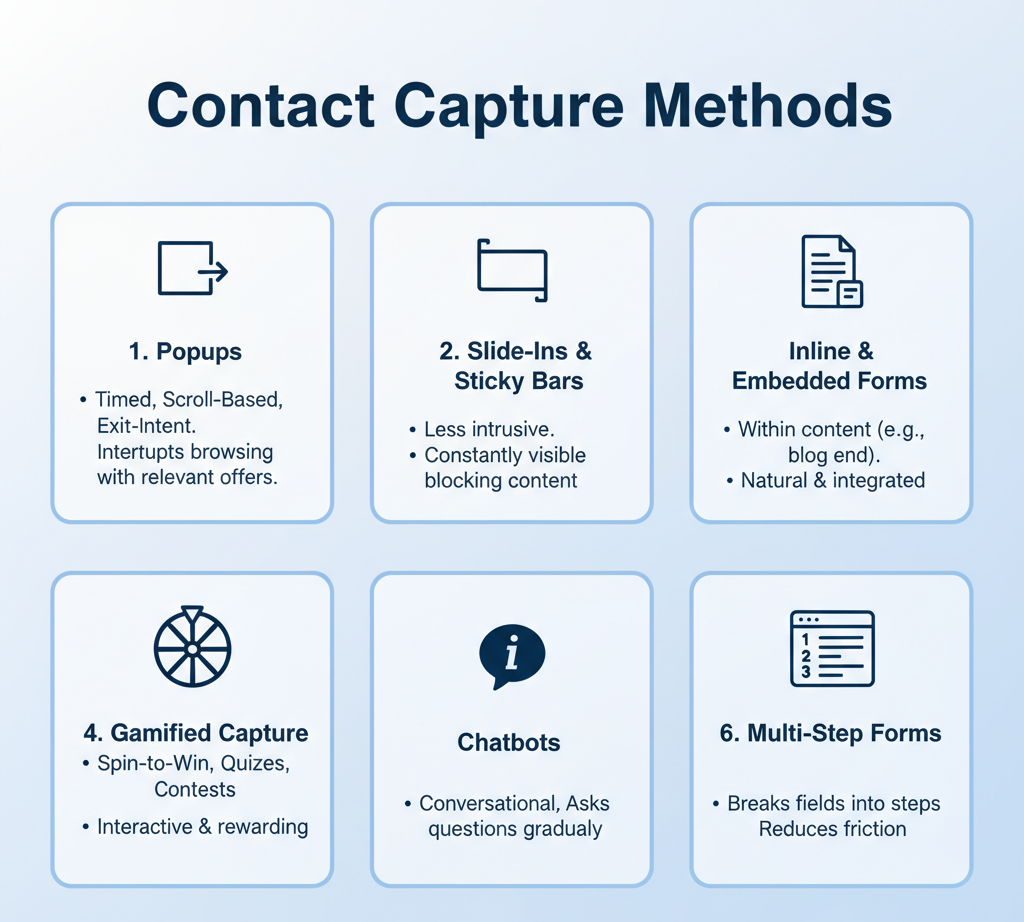
Not all contact capture methods are created equal. Choosing the right method depends on your audience, goals, and the type of engagement you want. Let’s break down the most effective options.
Popups (Timed, Scroll-Based, Exit Intent)
Popups are the most common and versatile method for capturing contacts.
Timed popups: Appear after a set number of seconds on the page.
Scroll-based popups: Trigger after a user scrolls a certain percentage of content.
Exit-intent popups: Appear when the user is about to leave the page.
Why popups work: They interrupt passive browsing at the right moment, delivering offers or content relevant to the visitor.
Example:
A visitor reads 70% of your blog post — an exit-intent popup offers a free downloadable guide in exchange for their email.
Slide-Ins and Sticky Bars
Slide-ins appear subtly from the corner of the screen, while sticky bars stay fixed at the top or bottom of a page.
Benefits:
Less intrusive than popups
Constantly visible without blocking content
Can include special offers, email capture forms, or announcements
Example:
A sticky bar at the top: “Sign up to get weekly marketing tips!”
Inline and Embedded Forms
Inline forms are placed within the page content, like at the end of a blog post or within a landing page.
Advantages:
Feels natural and integrated
Works well for high-intent visitors
Supports multiple fields if needed
Example:
At the end of a tutorial: “Enter your email to get the complete checklist PDF.”
Gamified Capture (Spin-to-Win, Quizzes, Contests)
Gamification makes contact capture fun and interactive, increasing engagement:
Spin-to-Win: Users enter an email to spin a wheel for prizes.
Quizzes: Capture emails to deliver results or scores.
Contests: Sign up to enter giveaways.
Why it works: Gamified experiences trigger curiosity and reward-seeking behavior, making visitors more willing to share info.
Chatbots and Conversational Capture Tools
Chatbots engage visitors in a conversation and can capture contact info naturally:
Ask questions gradually instead of showing a form upfront
Personalize the experience based on visitor responses
Can integrate with CRM systems for automated follow-ups
Example:
Chatbot: “Hi! Want tips to boost your website traffic? Share your email and I’ll send you a free guide.”
Best Practices for Maximizing Contact Capture Success
Collecting contacts is one thing; maximizing the success of your contact capture campaigns is another. Following best practices ensures higher conversions, better engagement, and quality leads.
Keep It Relevant and Personalized
Generic popups rarely convert. Personalization increases engagement:
Show offers based on visitor behavior (pages visited, scroll depth, or time on site).
Use dynamic content: Include the visitor’s name or refer to the product they viewed.
Example:
A visitor browsing “SEO tips” sees a popup: “Hi! Want our free SEO checklist? Enter your email to download.”
Optimize for Mobile Devices
With over 60% of web traffic on mobile, mobile optimization is critical:
Ensure popups are responsive and don’t cover essential content.
Use large buttons and readable text.
Avoid intrusive placements that frustrate mobile users.
Tip: Test popups on multiple devices to ensure a smooth experience.
Test Offers, Copy, and Designs Regularly
Even small changes can dramatically affect conversions.
A/B test different headlines, copy, colors, and CTA placement.
Test timing and triggers: Early vs. late popups, scroll-based vs. exit-intent.
Use analytics to identify which version drives the highest submissions.
Example Table: A/B Test Comparison
| Variant | CTA Copy | Conversion Rate |
|---|---|---|
| A | “Subscribe Now” | 12% |
| B | “Get Your Free Guide” | 28% |
Use Social Proof and Trust Indicators
Visitors are more likely to submit contact info when they see others’ positive engagement:
Testimonials and reviews
Subscriber counts (“Join 10,000+ marketers”)
Verified trust badges or privacy indicators
Example:
Popup: “Join 15,000+ marketers who get weekly growth tips delivered to their inbox.”
Follow Up Immediately After Capture
The moment a visitor submits their info is prime engagement time:
Send a welcome email or thank-you message immediately.
Deliver the promised incentive (ebook, discount code) right away.
Set expectations for future communication to maintain trust.
Data Privacy, Consent, and Compliance
Collecting contacts comes with responsibility. Visitors are trusting you with their personal information, and compliance with privacy laws is essential — both legally and for building trust.
Understanding GDPR, CCPA, and Global Data Laws
Depending on where your visitors are, you may need to comply with:
GDPR (EU): Requires explicit consent before collecting personal data.
CCPA (California, USA): Grants users the right to know, delete, or opt-out of the sale of their data.
Other global laws: Many countries now enforce privacy regulations, making compliance a must.
Why it matters: Non-compliance can lead to hefty fines, legal issues, and damage to your brand reputation.
Designing Transparent and Honest Opt-Ins
Transparency builds trust and improves submission rates:
Clearly explain what data is collected and why.
Show how it will be used (newsletters, offers, or updates).
Avoid pre-ticked checkboxes — explicit consent works best.
Example:
“Enter your email to get weekly marketing tips. We’ll never spam you, and you can unsubscribe anytime.”
Handling User Data Securely
Security is non-negotiable:
Encrypt stored data to prevent breaches.
Limit access to sensitive information.
Regularly audit your systems for vulnerabilities.
Giving Users Control Over Their Data (Opt-Outs, Preferences)
Users want freedom and transparency:
Provide easy unsubscribe options.
Allow users to update preferences or limit the type of communication.
Be responsive to data deletion or access requests.
Example Table: User Data Control Options
| Option | Description | Benefit |
|---|---|---|
| Opt-Out | User unsubscribes from emails | Builds trust |
| Preference Center | Select type of content or frequency | Personalizes experience |
| Data Access/Delete | Request stored information | Transparency & compliance |
Integrating Contact Capture into Your Marketing Funnel
Collecting contact information is only the first step. To maximize ROI, you need to integrate captured contacts into your marketing funnel and turn leads into loyal customers.
Mapping Captured Leads to Funnel Stages
Not all captured contacts are the same. Segmenting leads based on their behavior and intent is crucial:
Top of Funnel (TOFU): New visitors, casual readers, first-time form submissions.
Middle of Funnel (MOFU): Interested users who have interacted with content, attended webinars, or downloaded resources.
Bottom of Funnel (BOFU): Ready-to-buy prospects who have requested demos or product trials.
Example:
A visitor downloading an SEO guide is a TOFU lead, while someone requesting a free trial is a BOFU lead.
Lead Nurturing through Automated Emails
Once contacts are captured, timely nurturing increases conversions:
Send welcome emails immediately after submission.
Use email sequences based on interests or behavior.
Include personalized content relevant to their needs.
Example:
TOFU lead: “Thanks for downloading the guide! Here are 3 bonus tips to boost traffic.”BOFU lead: “Try our premium plan free for 7 days — see how it can triple your results.”
Retargeting Captured Visitors with Ads
Contacts who don’t convert immediately can still be engaged via retargeting campaigns:
Show ads based on pages visited or products viewed.
Combine retargeting with personalized offers or incentives.
Use captured emails for social media or Google Ads targeting.
Example:
Turning Captured Contacts into Conversions and Loyal Customers
The ultimate goal is conversion and retention:
Segment leads and deliver personalized offers.
Follow up with value-driven content: newsletters, tips, or updates.
Encourage loyalty programs or exclusive access to premium content.
Measuring and Optimizing Performance
Capturing contacts is valuable only if you track performance and continuously optimize. Measuring results helps you identify what works, what doesn’t, and where improvements can increase conversions.
Key Metrics to Track (Views, Clicks, Conversions)
The first step is knowing what to measure:
| Metric | What It Shows | Why It Matters |
|---|---|---|
| Views/Impressions | How many visitors saw your popup/form | Indicates reach and visibility |
| Clicks | How many clicked the CTA | Measures engagement with your offer |
| Conversions | How many submitted info | Ultimate success metric for lead generation |
| Conversion Rate | % of visitors who submit | Shows effectiveness of design, copy, and targeting |
Running A/B Tests on Popups and Forms
A/B testing helps determine the most effective variations:
Test headlines, CTAs, colors, and placement.
Test triggers: time-based, scroll-based, or exit-intent.
Compare different incentives: eBooks, discounts, or trials.
Example Table: A/B Test Results
| Variant | CTA Text | Trigger Type | Conversion Rate |
|---|---|---|---|
| A | “Subscribe Now” | 30s Delay | 12% |
| B | “Get Your Free Guide” | Scroll 50% | 27% |
Identifying Drop-Off Points and Reducing Abandonment
Analyzing user behavior helps you spot where leads abandon the process:
Track form abandonment: Are users leaving at a specific field?
Observe popup interactions: Are visitors closing popups without acting?
Adjust copy, design, and number of fields to remove friction.
Example:
If most visitors abandon after entering their email, consider removing extra fields or simplifying your CTA.
Using Analytics and Heatmaps for Continuous Improvement
Analytics tools and heatmaps provide visual insights into visitor behavior:
See where users click, scroll, and hover.
Identify high-engagement areas and missed opportunities.
Optimize popup placement, timing, and content based on real data.
How to Do Contact Capture Using Poper
With Poper, contact capture is effortless and highly effective. Whether you’re new or experienced, you can create smart popups, forms, and gamified experiences that convert visitors into leads.
Setting Up Your First Contact Capture Popup
Log in to your Poper dashboard.
Click “Create New Popup”.
Choose the goal: email collection, lead generation, or feedback.
Select a template or start from scratch.
Choosing from Poper’s Pre-Built Templates
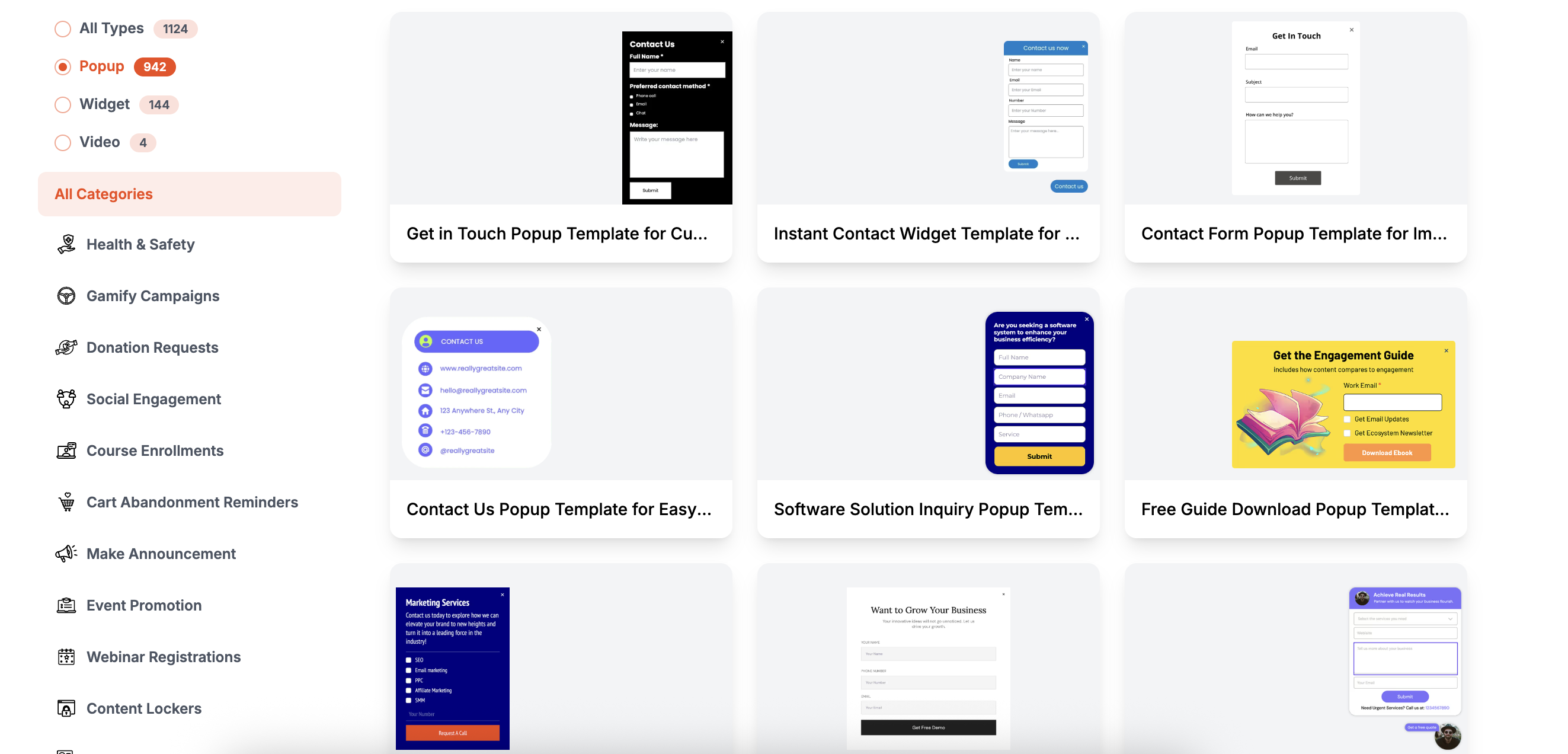
Poper offers variety and flexibility:
Form templates: Clean, simple, high-conversion forms.
Gamified templates: Spin-to-win, quizzes, or contests to engage visitors.
Exit-intent templates: Capture leads before they leave your site.
Example: A “Spin-to-Win” template can increase sign-ups by up to 30% compared to static forms.
Customizing Design, Copy, and Triggers
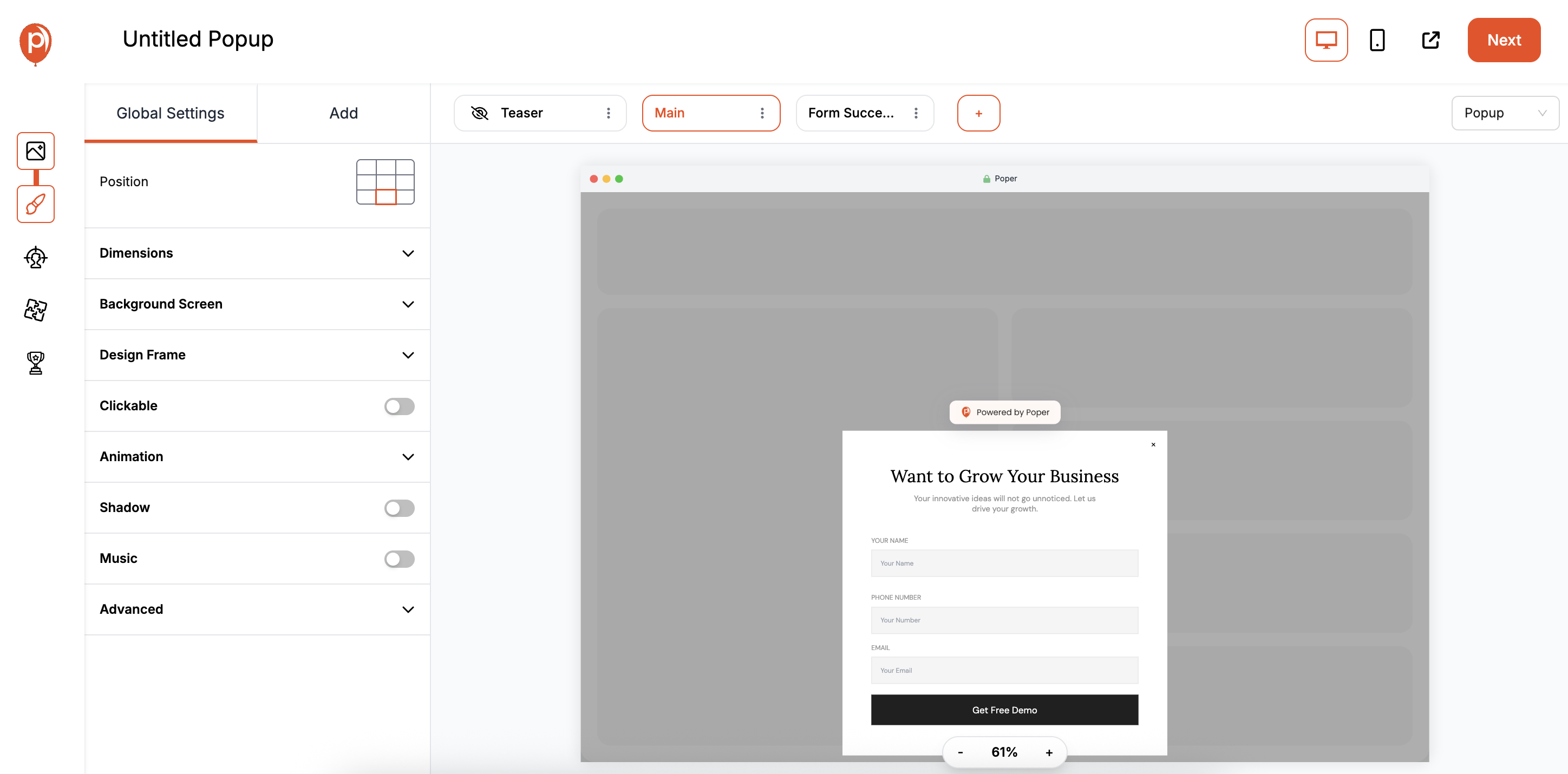
Modify headlines, CTAs, colors, and images to match your brand.
Choose display triggers: time on page, scroll depth, or exit-intent.
Adjust frequency settings to avoid annoying repeat visitors.
Adding Form Fields and Integrating with Email Tools
Add only essential fields: Name and Email for best conversion.
Integrate Poper with tools like Mailchimp, HubSpot, or Zapier to automatically sync leads.
Use conditional fields to ask additional info only when needed.
Segmenting Your Audience and Showing Popups Dynamically
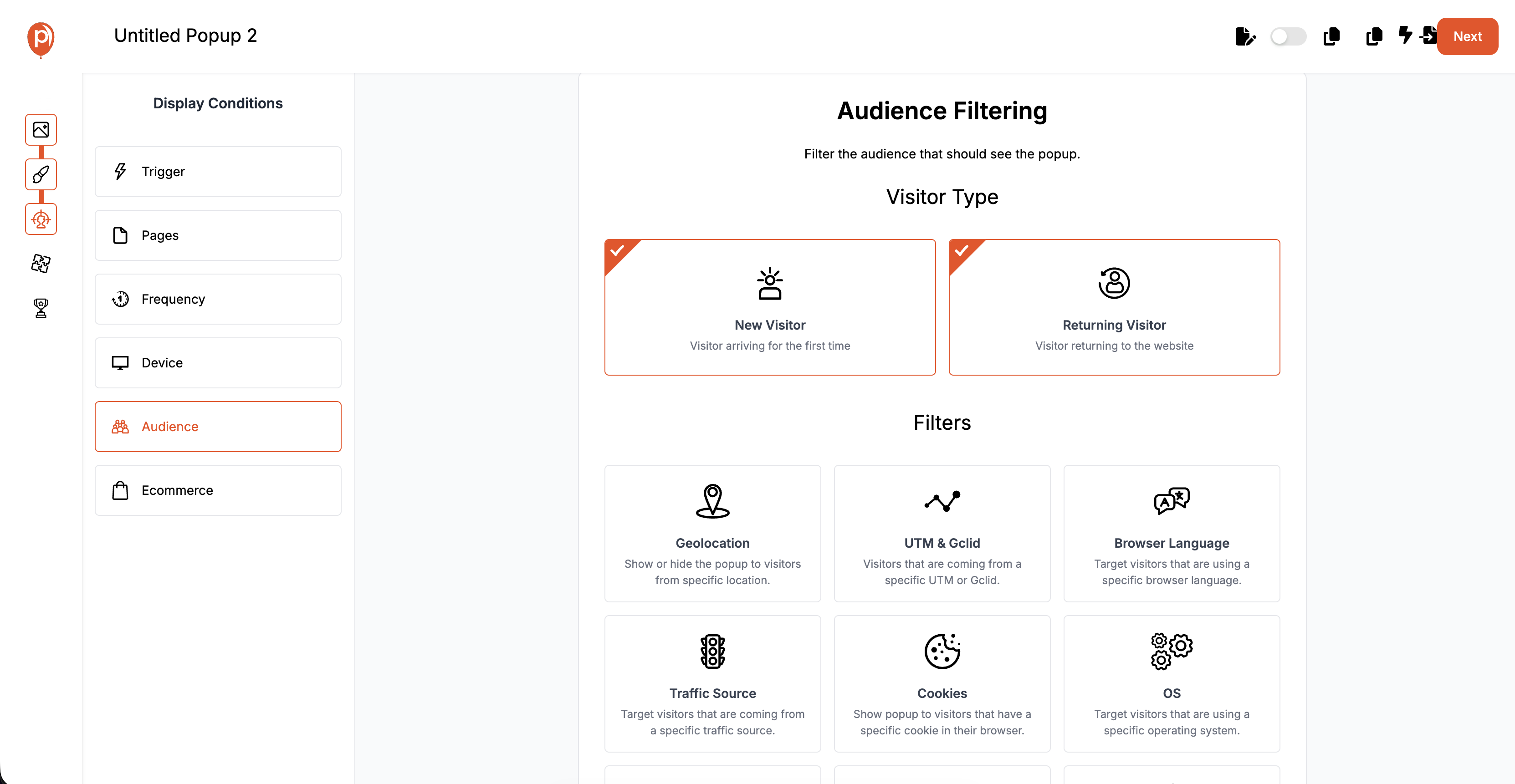
Show different popups to first-time vs. returning visitors.
Target based on page, behavior, or geolocation.
Example:
Returning visitors see a “Get 10% off your next order” popup, while new visitors get a free guide.
Tracking Performance through Poper’s Analytics Dashboard
Monitor impressions, clicks, conversions, and A/B test results.
Identify which popups or forms are underperforming.
Use insights to optimize offers, triggers, and design.
Running A/B Tests to Find the Best Converting Version
Duplicate popups and modify copy, design, or triggers.
Let Poper split traffic automatically and show results.
Implement the winning variant for maximum conversions.
The Future of Contact Capture
Contact capture is evolving rapidly. Modern technologies, privacy-first practices, and multi-channel approaches are shaping the next generation of lead generation strategies.
AI-Powered Personalization and Predictive Popups
AI analyzes visitor behavior to predict intent and display the most relevant offers.
Personalized popups increase engagement and conversion rates by showing the right content at the right time.
Example:
Returning visitors who browsed a pricing page see a limited-time discount popup, while new visitors see a free guide offer.
Cookie-Less Tracking and Privacy-First Engagement
With browsers phasing out third-party cookies, privacy-first tracking is essential.
Use consent-based methods to collect behavioral insights without compromising privacy.
Future popups will rely on contextual engagement, not invasive tracking.
Multi-Channel Capture (Web, Mobile, Chat, Email)
Contact capture is no longer limited to websites.
Integrate forms and popups across mobile apps, chat platforms, and email campaigns.
Multi-channel capture ensures you meet your audience wherever they are, increasing lead potential.
Seamless Integration Between Marketing Tools and Platforms
Modern capture tools like Poper integrate seamlessly with CRMs, email marketing, and automation platforms.
This enables smooth lead nurturing, follow-ups, and performance tracking across channels.
Summary
Contact capture is no longer just about collecting emails. It’s about building meaningful relationships, delivering value, and guiding visitors through your funnel.
With strategies that include psychology-driven design, personalized offers, behavioral triggers, gamification, and compliant data handling, you can maximize conversions.
Poper makes it easy by providing templates, smart targeting, analytics, A/B testing, and GDPR-compliant tools. By adopting modern strategies, businesses can turn every visitor into a high-quality lead and loyal customer.
FAQs About Contact Capture
What is the difference between contact capture and lead generation?
Contact capture collects visitor details, while lead generation nurtures those contacts into paying customers.
What is the best time to display a contact capture popup?
Typically after 30–60 seconds on-page or at exit-intent, when users show engagement or intent to leave.
Do popups still work today?
Yes, when used strategically with personalization, timing, and relevant offers, popups remain highly effective.
How many fields should my contact form have?
Ideally, keep it under three fields: name, email, and one optional field for best conversion rates.
Can I use contact capture for different goals?
Absolutely. You can collect signups, feedback, demo requests, surveys, or contest entries.
